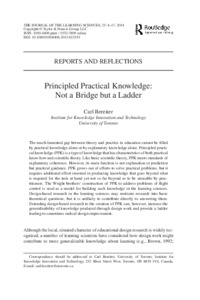Principled Practical KnowledgeNot a Bridge but a Ladder
Erstpublikation in: Journal of the Learning Sciences, 23:1, 4-17
Publikationsdatum:
|
 |
 Diese Seite wurde seit 6 Jahren inhaltlich nicht mehr aktualisiert.
Unter Umständen ist sie nicht mehr aktuell.
Diese Seite wurde seit 6 Jahren inhaltlich nicht mehr aktualisiert.
Unter Umständen ist sie nicht mehr aktuell.
 Zusammenfassungen
Zusammenfassungen
In this article I discuss a kind of generalizable knowledge that can come out of design
work but that is not presumed to contribute directly to the advancement of learning
theory or any other basic theory. It is what I call principled practical knowledge
(PPK).
Von Carl Bereiter im Text Principled Practical Knowledge (2013) The much-lamented gap between theory and practice in education cannot be filled
by practical knowledge alone or by explanatory knowledge alone. Principled practical
knowledge (PPK) is a type of knowledge that has characteristics of both practical
know-how and scientific theory. Like basic scientific theory, PPK meets standards of
explanatory coherence. However, its main function is not explanation or prediction
but practical guidance. PPK grows out of efforts to solve practical problems, but it
requires additional effort invested in producing knowledge that goes beyond what
is required for the task at hand yet not so far beyond as to be unusable by practitioners.
The Wright brothers’ construction of PPK to address problems of flight
control is used as a model for building such knowledge in the learning sciences.
Design-based research in the learning sciences may motivate research into basic
theoretical questions, but it is unlikely to contribute directly to answering them.
Extending design-based research to the creation of PPK can, however, increase the
generalizability of knowledge produced through design work and provide a ladder
leading to sometimes radical design improvement.
Von Carl Bereiter im Text Principled Practical Knowledge (2013)  Dieser wissenschaftliche Zeitschriftenartikel erwähnt ...
Dieser wissenschaftliche Zeitschriftenartikel erwähnt ...
 Personen KB IB clear | Katherine Bielaczyc , Ann L. Brown , Allan Collins , Diana Joseph , Alan Newell , Ikujiro Nonaka , Herbert Simon , Hirotaka Takeuchi , Lew Semjonowitsch Vygotsky | ||||||||||||||||||||||||||||||||||||
 Begriffe KB IB clear | design-based researchdesign-based research
,  Lernen Lernen learning
, Theorietheory
, learning
, Theorietheory
,  Wissenschaft Wissenschaft science science
| ||||||||||||||||||||||||||||||||||||
 Bücher |
| ||||||||||||||||||||||||||||||||||||
 Texte |
|
 Zitationsgraph
Zitationsgraph
 Zitationsgraph (Beta-Test mit vis.js)
Zitationsgraph (Beta-Test mit vis.js)
 Anderswo finden
Anderswo finden
 Volltext dieses Dokuments
Volltext dieses Dokuments
 |  Principled Practical Knowledge: Artikel als Volltext ( Principled Practical Knowledge: Artikel als Volltext ( : :  , 97 kByte; , 97 kByte;  : :  ) ) |
 Anderswo suchen
Anderswo suchen 
 Beat und dieser wissenschaftliche Zeitschriftenartikel
Beat und dieser wissenschaftliche Zeitschriftenartikel
Beat hat Dieser wissenschaftliche Zeitschriftenartikel während seiner Zeit am Institut für Medien und Schule (IMS) ins Biblionetz aufgenommen. Er hat Dieser wissenschaftliche Zeitschriftenartikel einmalig erfasst und bisher nicht mehr bearbeitet. Beat besitzt kein physisches, aber ein digitales Exemplar. Eine digitale Version ist auf dem Internet verfügbar (s.o.). Es gibt bisher nur wenige Objekte im Biblionetz, die dieses Werk zitieren.








 (
(




 Biblionetz-History
Biblionetz-History